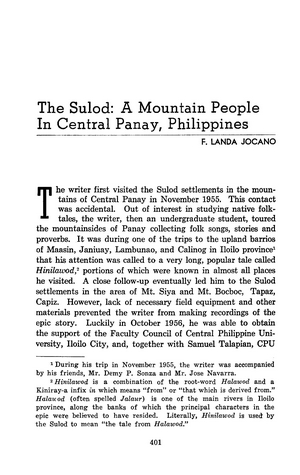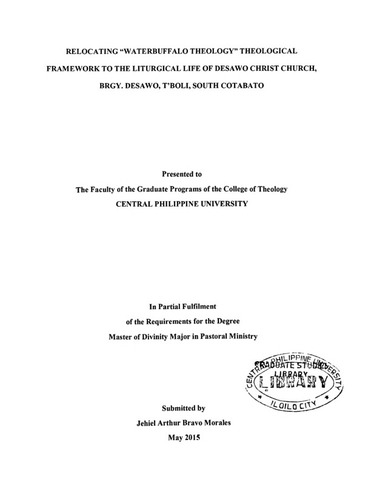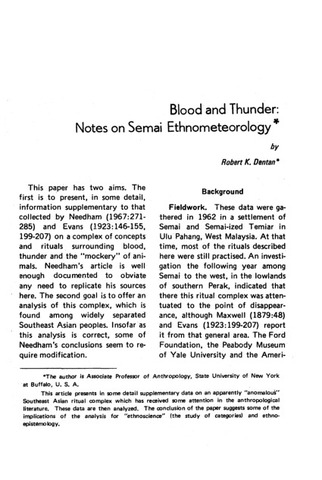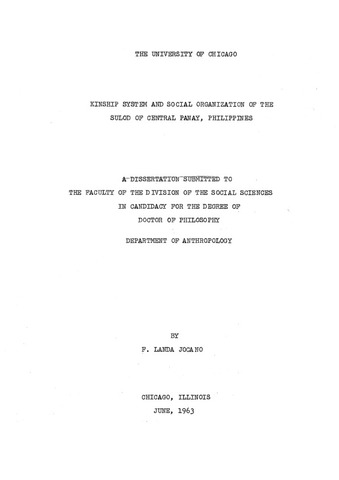The Sulod: A mountain people in Central Panay, Philippines
| dc.contributor.author | Jocano, F. Landa | |
| dc.date.accessioned | 2022-06-10T05:32:11Z | |
| dc.date.available | 2022-06-10T05:32:11Z | |
| dc.date.issued | 1958 | |
| dc.identifier.citation | Jocano, F. L. (1958). The Sulod: A mountain people in Central Panay, Philippines. Philippine Studies: Historical and Ethnographic Viewpoints, 6(4), 401–436. | en_US |
| dc.identifier.issn | 2244-1093 | |
| dc.identifier.uri | https://hdl.handle.net/20.500.12852/2085 | |
| dc.description | Journal article | en_US |
| dc.description.abstract | The writer first visited the Sulod settlements in the mountains of Central Panay in November 1955. This contact was accidental. Out of interest in studying native folktales, the writer, then an undergraduate student, toured the mountainsides of Panay collecting folk songs, stories and proverbs. It was during one of the trips to the upland barrios of Maasin, Janiuay, Lambunao, and Calinog in Iloilo province that his attention was called to a very long, popular tale called Hinilawod, portions of which were known in almost all places he visited. A close follow-up eventually led him to the Sulod settlements in the area of Mt. Siya and Mt. Bocboc, Tapaz, Capiz. However, lack of necessary field equipment and other materials prevented the writer from making recordings of the epic story. Luckily in October 1956, he was able to obtain the support of the Faculty Council of Central Philippine University, Iloilo City, and, together with Samuel Talapian, CPU radio technician, returned to the area and tape-recorded portions of the epic. This initial recording, however, was suspended after a week's time because the writer exhausted his funds and there was no immediate source where he could get additional financial assistance to carry on the field work. In May 1957 the Asia Foundation took interest in the project. Supported by a liberal grant-in-aid from the Foundation, the writer returned to the area in June of that year to complete the recording of the epic, and to make a brief socio-cultural study of Sulod life. Upon reaching the area, however, he found his former informant unwilling to cooperate. This forced him to look for other informants. After a week's travel over the rugged mountain passes, he met an old practicing babaylan or "medium," Hugan-an by name, who could sing the entire story from memory. Hunger which ravaged the area during this part of the year considerably hampered the field work. The writer returned to the University and made arrangements for the final recording of the epic. Then in August, accompanied by Antonio Bernardino, another CPU technician, he went back to the mountains and stayed there until October. This paper describes the Sulod people of Central Panay from the author's field work. | en_US |
| dc.description.sponsorship | Central Philippine University and the Asia Foundation | en_US |
| dc.language.iso | en | en_US |
| dc.publisher | Ateneo de Manila University | en_US |
| dc.relation.uri | http://www.philippinestudies.net/ojs/index.php/ps/article/download/3134/5683 | en_US |
| dc.subject.lcsh | Sulod (Philippine people) | en_US |
| dc.subject.lcsh | Ethnology | en_US |
| dc.subject.lcsh | Philippines--Panay Island | en_US |
| dc.subject.lcsh | Indigenous peoples--Social life and customs | en_US |
| dc.subject.lcsh | Indigenous peoples | en_US |
| dc.subject.lcsh | Sulod (Philippine people)--Social life and customs | en_US |
| dc.title | The Sulod: A mountain people in Central Panay, Philippines | en_US |
| dc.type | Article | en_US |
| dcterms.accessRights | Publicly accessible | en_US |
| dc.citation.firstpage | 401 | en_US |
| dc.citation.lastpage | 436 | en_US |
| dc.citation.journaltitle | Philippine Studies: Historical and Ethnographic Viewpoints | en_US |
| dc.citation.volume | 6 | en_US |
| dc.citation.issue | 4 | en_US |
| local.subject | Central Panay | en_US |
| local.subject | Panay Bukidnon | en_US |
| dc.identifier.essn | 2244-1638 |
이 항목의 파일
This item appears in the following Collection(s)
-
Journal articles [36]





